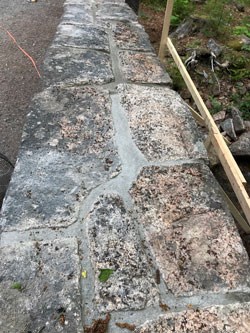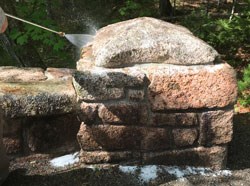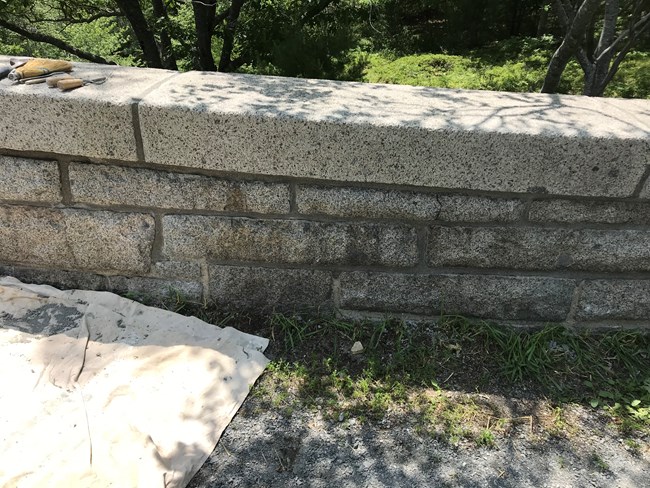Last updated: October 14, 2021
Article
Repointing Acadia's Historic Carriage Road Bridges
In 2019, Acadia National Park and the NPS Historic Preservation Training Center began cleaning and repairing some of the park's historic carriage road bridges. The team is cleaning the stone masonry bridges using a biological cleaning solution, remove failed and deteriorating motar joints, and repoint the mortar joints with an approved mortar that matches the historic mortar in color, texture, and composition.
The beautiful and historic carriage road bridge of Acadia National Park are constructed of reinforced concerete with native stone used as facing stones to blend in with the natural surroundings. The bridges were full restored within the last decade, but weather and water have deterirating the mortar in between the stone. The process of removing and replacing this mortar is called repointing.
The National Park Service takes great care in preserving these treasured historic structures. Throughout the project diary, you will see the methodical nature of our work and the lengths we go to to maintain the historic nature and character of these structures.
Project Diary
Week One: Staging and Little Harbor Brook Bridge
Park maintenance and cultural preservation staff met with HPTC staff to plan for the project. Staging began as the work crew took a trip to the Little Harbor Brook Bridge to determine which tools and equipment would be needed to begin the project and set up a staging area. To reach the height of the bridge, the project team cut cribbing material from 6x6 inch lumber.
Cribbing or blocking is a temporary wooden structure used to support heavy objects during construction.
Once the cribbing was cut, screwed together, and placed on level surfaces, a 20 foot long pick, or walkway, was put into place on top of the cribbing to establish the height needed to rake and repoint the faces of the bridge. Guard rails were also added. A large tarp was then stretched out under the bridge and secured in place to catch debris caused by the raking (removing) and repointing of the mortar.
Now that the worksite was staged, the crew removed moss and organic growth from the bridge in preparation for re-pointing the mortar joints and applying biological cleaning solution to the surfaces.
Removing Moss and Organic Material


Left image
Moss covering a carriage road bridge
Credit: NPSPhoto
Right image
Moss and organic matter were cleaned and removed to make way for repointing
Credit: NPSPhoto
Work began sounding and removing deteriorated mortar joints. Sounding is a technique by which you tap on the joint and can tell by its sound if the joints are deteriorated.
It was determined that the majority of the skyward facing mortar joints on the capstones should be removed. The crew began removing the capstone mortar joints. Once the mortar joints were removed using light duty demolition hammers, air tools, and hand tools, the joints were swept out using small hand held brushes. After brushing the joints thoroughly, a small shop vacuum was used to remove the remaining debris.

NPSPhoto
Week Two: Little Harbor Brook Bridge
The team then began repointing the mortar joints of the capstones and parapet walls. Once the mortar is initially set, small sponges dampened with water finished the joints to slightly expose the aggregate to match the historic mortar joints.
This week the project team was presented with the challenge of a very large rainstorm. In preparation for rain on Wednesday, the crew setup 10 feet by 10 feet pop-up canopies on one side of the bridge. Two legs of each canopy sat on the gravel road approximately 4 feet from the wall. The two remaining legs of each canopy were attached to the wooden guardrail system that had been put in place the previous week.
By week's end, the repointing work on Little Harbor Brook Bridge was approximately 80% complete and the crew began scoping out its next worksite located near Wildlwood Stables.

NPSPhoto
Week Three: Finishing Little Harbor Brook Bridge and Working on a Small Road Bridge
This week several crew members went back to Little Harbor Brook Bridge to spray D/2 biological solution onto the surfaces of the stones. Prior to applying the D/2, drop cloths were placed on the metal picks to prevent any excess material from falling into the brook. Using hand pump sprayers, the D/2 was carefully applied to the surfaces of the stones. The D/2 was applied 3 times, allowing 15 minutes of dwell time between applications.
At the same time, part of the project team began preparing a work site for work to begin on a small road bridge near Wildwood Stables. All of the remaining deteriorated mortar joints were removed. A leaf blower was used to remove any remaining loose debris and dirt caused during the removal of the deteriorated mortar joints. The crew laid a tarp down to catch all of the debris so that it wouldn't go into the stream. Since there isn't water at the site, the crew filled 150-200 gallon water tanks and trucked them to the work site for using in the mortar mix and for pressure washing.
Back at Little Harbor Brook Bridge, the crew pressure washed the bridge using a portable 100 gallon tank of water and applied the final application of D/2 solution using hand pump sprayers. The team completed repointing and raking joints, and collecting all the debris from the project onto tarps to protect the stream. With work complete at this bridge, all of the cribbing and wooden guardrails that supported the team during their work was removed and the site was returned to its original state prior to preservation tasks being carried out. All the lumber was put into storage in our maintenance facility to be reused at the next bridge.
Before and After: Repointing


Left image
The old mortar is removed and the wall cleaned.
Credit: NPSPhoto
Right image
The complete repointed wall.
Credit: NPSPhoto
Week 4: Duck Brook Bridge
Using much of the same techniques as week's past, the crew turned their sites on Duck Brook Bridge this week. This bridge sees a high volume of foot and bike traffic so extra precaution was taken with caution tape and cones blocking off the area. With the July 4th holiday looming, this week's task was to begin raking the mortar joints, removing the deteriorated mortar from the capstones as well as the parapet wall.- Duration:
- 2 minutes, 13 seconds
Learn how the masons and cultural resource manager at Acadia National Park match new mortar to historic samples while repairing the carriage road bridges as part of the Trades Alive video series.

Week 5: Duck Brook Bridge
After meeting with Acadia National Park staff, the crew began pressure washing the Duck Brook Bridge from a 200 gallon water tank they had trucked to the site. With mortar mixed, the crew began re-pointing the mortar joints on the cleaned portion of the bridge. Using a damp sponge, the team finished the joints to match the historic mortar joints ont he bridge.

Left image
East side of Duck Brook Bridge prior to pressure washing tasks being started.
Right image
East side of Duck Brook Bridge after pressure washing tasks were completed.
